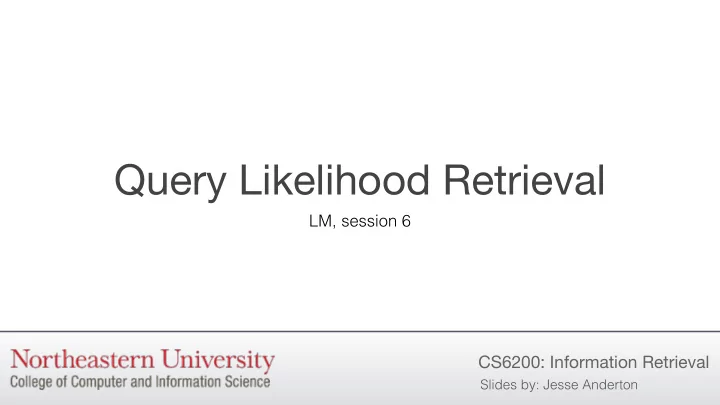

Query Likelihood Retrieval LM, session 6 CS6200: Information Retrieval Slides by: Jesse Anderton
Retrieval With Language Models So far, we’ve focused on language models like P ( D = w 1 , w 2 , …, w n ). Where’s the query? Remember the key insight from vector space models: we want to represent queries and documents in the same way. The query is just a “short document:” a sequence of words. There are three obvious approaches we can use for ranking: 1. Query likelihood: Train a language model on a document, and estimate the query’s probability. 2. Document likelihood: Train a language model on the query, and estimate the document’s probability. 3. Model divergence: Train language models on the document and the query, and compare them.
Query Likelihood Retrieval Suppose that the query specifies a topic. We want to know the probability of a document being generated from rank P ( D | Q ) = P ( Q | D ) P ( D ) that topic, or P ( D | Q ) . = P ( Q | D ) Assuming uniform prior However, the query is very small, and � documents are long: document = P ( w | D ) Naive Bayes unigram model language models have less variance. w ∈ Q rank � In the Query Likelihood Model , we use = log P ( w | D ) Numerically stable version Bayes' Rule to rank documents based w ∈ Q on the probability of generating the query from the documents’ language models.
Example: Query Likelihood Wikipedia: WWI Query: “deadliest war in history” World War I ( WWI or WW1 or World War One ), Term P(w|D) log P(w|D) also known as the First World War or the Great War , was a global war centred in Europe deadliest 1/94 = 0.011 -1.973 that began on 28 July 1914 and lasted until 11 war 6/94 = 0.063 -1.195 November 1918. More than 9 million combatants and 7 million civilians died as a in 3/94 = 0.032 -1.496 result of the war, a casualty rate exacerbated by the belligerents' technological and industrial history 1/94 = 0.011 -1.973 sophistication, and tactical stalemate. It was Π = 2.30e-7 Σ = -6.637 one of the deadliest conflicts in history, paving the way for major political changes, including revolutions in many of the nations involved.
Example: Query Likelihood Query: “deadliest war in history” Wikipedia: Taiping Rebellion Term P(w|D) log P(w|D) The Taiping Rebellion was a massive civil war in southern China from 1850 to 1864, deadliest 1/56 = 0.017 -1.748 against the ruling Manchu Qing dynasty. It war 1/56 = 0.017 -1.748 was a millenarian movement led by Hong Xiuquan, who announced that he had in 2/56 = 0.035 -1.447 received visions, in which he learned that he history 1/56 = 0.017 -1.748 was the younger brother of Jesus. At least 20 million people died, mainly civilians, in one of Π = 2.56e-8 Σ = − 6.691 the deadliest military conflicts in history.
Wrapping Up There are many ways to move beyond this basic model. • Use n-gram or skip-gram probabilities, instead of unigrams. • Model document probabilities P ( D ) based on length, authority, genre, etc. instead of assuming a uniform probability. • Use the tools from the VSM slides: stemming, stopping, etc. Next, we’ll see how to fix a major issue with our probability estimates: what happens if a query term doesn’t appear in the document?
Recommend
More recommend